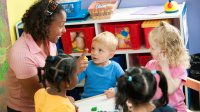Allowing Preschool Students to Guide Instruction
When the youngest students get to have a say in the classroom, their work feels more meaningful to them.
Your content has been saved!
Go to My Saved Content.During a coaching session, a teacher shared that she was interested in long-term projects that would be more meaningful for the children. She wanted to do a study around boxes. She had planned to start with giving the children milk boxes with a variety of materials to have them create their own homes. She said, “I want their homes to be meaningful to them so they can create using any materials provided.”
Something stirred inside of me, and I said, “If you are looking for meaningful, you may need to go back to the beginning of your study.”
She tilted her head and asked, “What do you mean?"
I replied, “What do the children want to do with boxes? Have you asked them?”
Since this teacher has great skills and is sharp-minded, she immediately got it. She worked out a plan to write the children’s ideas on a large piece of paper and have them vote. She would then use these ideas each week. She also would make a list of the materials they wanted to work with and have them draw out their ideas before creating. I asked her to document the process from beginning to end, creating a story of the children’s journey with images and narratives.
Teachers are right on point when they want children to do deeper learning and have meaningful experiences. These lessons tap into intrinsic motivation where one does an activity based on an internal satisfaction or extrinsic motivation where one works hard to gain something. But how do you make things meaningful for children? First, we must look at what the word meaningful means.
Defining ‘Meaningful’
Lexico.com defines meaningful as “having a serious, important, or useful quality or purpose.”
It feels warm and fuzzy inside to think of having purpose or value. While I could give examples of what’s “meaningful,” it would be pointless. What’s meaningful to one person will be meaningless for another. Even now, when reading the definition above, readers have their own ideas of what feels purposeful or important.
Everyone comes from different backgrounds and has a variety of experiences. We have diverse personalities and preferences, influencing what we want or value. We cannot control meaning for anyone but ourselves.
If meaning is subjective, then teachers are not the experts on what’s meaningful to a child. Only the child knows, and the only way to find out is to ask.
A Hard Ask?
It’s easy to ask but hard to listen. All day, teachers can ask children what they want. However, the teacher may have their own thoughts on what to implement and may not listen whatsoever to the children. After all, teachers know what’s best. However, the goal is to create meaning for children, not for teachers. This is the children’s environment and experience. Everything affects them.
A teacher gets warm fuzzies from planning and implementing their ideas into curriculum and environment—perhaps the children might like that as well.
Maybe they have ideas for the washing hands charts or the classroom job poster. Perhaps they can make the center labels with their own handwriting and pictures. Maybe they would like to pick the theme for the drama area. All of this naturally builds developmental skills (social and emotional, cognitive, math, literacy, fine motor, etc.). In addition, they will have high motivation to participate.
Imagine the positive emotions (pride, belonging, acknowledgment) that children will feel when their suggestions come to life in the classroom.
If a suggestion is not appropriate or realistic, teachers can facilitate modifications or alternatives. “Hmmm, we don’t have enough cardboard to make life-sized boats for everyone—what’s another way we can still make boats? Any ideas?” Children will learn to hear from others, negotiate, and make a responsible decision.
Trusting Our Students
Children have an innate desire to learn and explore. They want to touch things, figure things out, break things down, and build them back up. Due to limited societal influences, their creativity and innovation have no boundaries. Humans survived through time by creating, experimenting, and learning. In the past, if we had had limited scientists and inventors, there would be no new discoveries or technology.
Real teaching is giving children materials, facilitating exploration, and guiding their talents and abilities. Teachers can surround young students with a safe environment to explore and trust them to test out theories or make a few mistakes.
When children get opportunities and resources, what they dream up and suggest can be mind-blowing. Maybe they want to use a box to make a rocket ship car or a two-person movie theater with popcorn. Even if it looks a bit funky and does not meet adult standards, it will not bother them because they designed it.
Creating meaning gets easier once a teacher facilitates and follows the children’s lead, making room for their contributions. They will be more excited to create and experiment because it was their idea.
